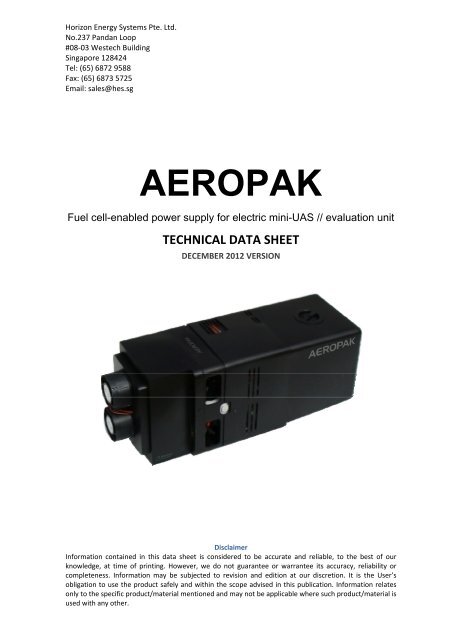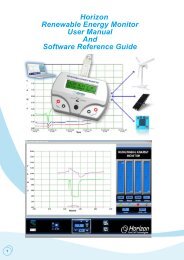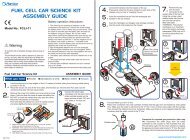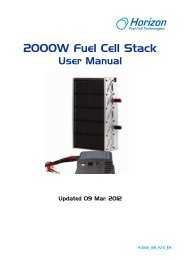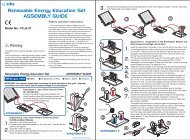Technical Data Sheet - Horizon Energy Systems
Technical Data Sheet - Horizon Energy Systems
Technical Data Sheet - Horizon Energy Systems
You also want an ePaper? Increase the reach of your titles
YUMPU automatically turns print PDFs into web optimized ePapers that Google loves.
<strong>Horizon</strong> <strong>Energy</strong> <strong>Systems</strong> Pte. Ltd.<br />
No.237 Pandan Loop<br />
#08‐03 Westech Building<br />
Singapore 128424<br />
Tel: (65) 6872 9588<br />
Fax: (65) 6873 5725<br />
Email: sales@hes.sg<br />
AEROPAK<br />
Fuel cell-enabled power supply for electric mini-UAS // evaluation unit<br />
TECHNICAL DATA SHEET<br />
DECEMBER 2012 VERSION<br />
Disclaimer<br />
Information contained in this data sheet is considered to be accurate and reliable, to the best of our<br />
knowledge, at time of printing. However, we do not guarantee or warrantee its accuracy, reliability or<br />
completeness. Information may be subjected to revision and edition at our discretion. It is the User’s<br />
obligation to use the product safely and within the scope advised in this publication. Information relates<br />
only to the specific product/material mentioned and may not be applicable where such product/material is<br />
used with any other.
AEROPAK Physical Features<br />
The standard AEROPAK configuration consists of a 200W fuel cell and a 900Wh chemical hydride<br />
based fuel cartridge. With a system specific energy greatly exceeding that of advanced lithiumpolymer<br />
batteries, the AEROPAK increases flight endurance of small and stealthy electric<br />
Unmanned Aerial <strong>Systems</strong> (UAS) by several orders of magnitude, creating new mission<br />
possibilities and enables new features not possible before.<br />
Figure 1. Views and dimensions of AEROPAK<br />
2
1. AEROPAK Performance Specifications<br />
Figure 2. Main parts of the AEROPAK<br />
The AEROPAK can deliver up to 10A of current. Its operating voltage ranges from 32V (no load) to<br />
21V (full load). The rated operating point of 10A@21V is recommended.<br />
2.1 Power output<br />
2.1.1 Power output characteristics<br />
Figure 3 below presents the voltage‐current characteristic and system‐to‐system variability bands<br />
of the fuel cell operating at normal room temperature. On average the system is capable of<br />
delivering around 10% more than the rated power of 200W.<br />
3
Power<br />
Voltage<br />
2.1.2 Peak power output<br />
Figure 3. Power output characteristics of the AEROPAK<br />
The AEROPAK can deliver a peak power output of 600W * to meet the high power requirements<br />
during UAS take‐off or climbs. This is realized by connecting a lithium‐polymer battery in parallel<br />
hybrid configuration. A power management card combines the total power output from fuel cell<br />
and hybrid battery before delivering to the load. It also recharges the battery when excess power<br />
is available from the fuel cell during cruise.<br />
*Peak power value and duration depend on the capacity of the hybrid battery module which is external to<br />
Aeropak. Customer can size the battery according to its peak power duration. Table 1 presents typical<br />
options. For any other requirements please contact us.<br />
Capacity Net Power Output Duration Estimated battery weight<br />
6S 730mAh 600W (400W from Battery) 1 min 134g<br />
6S 910mAh 600W (400W from Battery) 1.5 mins 164g<br />
6S 1350mAh 600W (400W from Battery) 2 mins 208g<br />
Table 1. Lithium polymer battery options for peak power output<br />
4
2.2 Fuel consumption rate<br />
Figure 4 presents the fuel consumption rate of the AEROPAK system at different power outputs<br />
under various ambient temperatures.<br />
Figure 4. Fuel consumption<br />
2.3 Control and communication<br />
Communication channel: RS232 serial byte format, 19200 bps, 8 data bits, no parity, 1 stop bit;<br />
Little‐endian format.<br />
Message frequency: 1 Hz. (1 second per message)<br />
Reportable parameters:<br />
Name <strong>Data</strong> Range Resolution Baud rate Frequency(Hz)<br />
Fuel Cell Stack Voltage 18‐35 0.1V 19200 1<br />
Fuel Cell Stack Current 0‐12 0.1A 19200 1<br />
Fuel Cell Power 0‐650 1W 19200 1<br />
Total <strong>Energy</strong> 0‐1000 1Wh 19200 1<br />
Fuel Cell Stack Temperature 0‐70 0.1C 19200 1<br />
Battery Voltage 18‐30 0.1V 19200 1<br />
Hydrogen Pressure 0‐10 0.1bar 19200 1<br />
Table 2. RS232 data and format<br />
3. AEROPAK Operating Environment Specifications<br />
5
3.1 Airflow requirements<br />
Fuel cell system requires airflow for reaction oxidant as well as cooling. Figure 5 below shows the<br />
estimated airflow requirements of the AEROPAK at different power outputs.<br />
Figure 5. Airflow requirement<br />
A slight contaminant level in the operating environment has insignificant effect on the AEROPAK<br />
performance over the full product lifetime. Exposure to high level of contamination in the<br />
operating environment will lead to a drop in performance drop, which may or may not be<br />
recoverable.<br />
If the operating environment is expected to be very dusty, a filter for the oxidant and cooling air<br />
may be required.<br />
6
3.2 Altitude & temperature<br />
Operating altitude affects the AEROPAK performance. At higher altitude, there is a reduced level<br />
of oxidant for reaction, leading to lower single cell voltages within the fuel cell stack. A slight<br />
drop in performance (power output level) can be expected typically at altitude 1000m above sea<br />
level.<br />
Another factor that affects the AEROPAK performance is ambient temperature. Higher<br />
temperature leads to the drying up of the proton exchange membranes inside the fuel cell stack,<br />
reducing proton conductivity and consequently the power output of the fuel cell.<br />
Figure 6. AEROPAK performance at various altitudes<br />
7
2500<br />
Altitude (m)<br />
2000<br />
1500<br />
1000<br />
500<br />
0<br />
‐40 ‐20 0 20 40 60<br />
Temperature °C<br />
‐500<br />
Figure 7. Applicable altitude range for the fuel cell system; the blue inner envelope represents operating<br />
conditions for fuel cell rated performance while the yellow outer envelope represents operating conditions<br />
for limited fuel cell performance.<br />
3.3 Environment temperature and humidity<br />
The AEROPAK can deliver its rated performance when operating at ambient temperature ranging<br />
0‐40°C and a relative humidity range of 10‐90%. At a given environment temperature, the<br />
AEROPAK performance increases with a higher level of relative humidity. Figure 8 shows the<br />
correlation between environment temperature/humidity and the AEROPAK performance.<br />
8
Sensitivity to the Environment T and RH<br />
200<br />
180<br />
Power @cell voltage of 0.7V (W)<br />
160<br />
140<br />
120<br />
100<br />
80<br />
60<br />
40<br />
RH=15%<br />
RH=30%<br />
RH=50%<br />
RH=90%<br />
20<br />
0<br />
0 5 10 15 20 25 30 35 40 45<br />
Temperature (°C)<br />
Figure 8. Effects of environment temperature & humidity on the AEROPAK performance<br />
3.4 Radiation and neutron radiation effects on the AEROPAK<br />
Impacts of radiation and neutron radiation on the AEROPAK have yet to be tested. Strong<br />
radiation and neutron radiation might cause damage to the AEROPAK.<br />
3.5 Shock and vibration<br />
The AEROPAK undergoes vibration and shock tests according to UL2267 standards (for vibration<br />
tests), and IEC‐68227Ea and IEC68229Eb (for shock tests).<br />
4. Lifetime and Performance Degradation<br />
The AEROPAK standard warranty is 500 operating hours at its rated performance. After 500<br />
hours operation, power degradation rate will be approximately 5% per 100 hour operation.<br />
Fuel cartridge is meant for one‐time use. Cartridges are disposable or returnable to <strong>Horizon</strong><br />
<strong>Energy</strong> <strong>Systems</strong> for refurbish.<br />
The fuel cell system will undergo reversible performance degradation after long term storage, up<br />
to a maximum power loss of 30%. System performance can be recovered after some conditioning.<br />
It is recommended that the AEROPAK is used at least once a month.<br />
9


